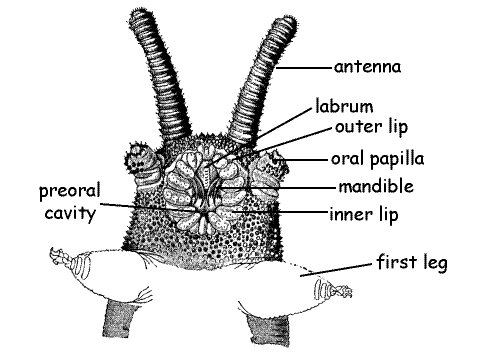
These fascinating creatures, often belonging to the phylum Onychophora, showcase a blend of features that can leave you in awe. Their anatomy has evolved over millions of years, allowing them to thrive in their moist habitats. Think of them as nature’s own little survival experts, equipped with specialized tools that help them hunt and defend themselves. Allow me to guide you through their anatomy and explain how these incredible features work together.
What Exactly Is a Velvet Worm?
Before diving into the specifics, it’s good to know what we’re dealing with. Velvet worms are a unique group of **invertebrates** that mostly roam the understory of tropical and subtropical forests. They have up to 43 pairs of legs, each tipped with a little claw, which helps them navigate the forest floor. Imagine being equipped with several tiny appendages that let you climb, crawl, and maneuver through tight spaces. These creatures can be quite small, measuring anywhere from a couple of centimeters to nearly 15 centimeters long.
What’s even more fascinating is their **slime production**. Velvet worms have specialized glands that secrete a sticky substance. This slime isn’t just for decoration; it’s a crucial part of their hunting strategy. Picture this: a velvet worm ambushing its prey with a quick burst of slime that can immobilize insects—it’s nature’s own little trap! The slime’s composition allows it to adhere strongly, making it hard for the prey to escape.
Exploring Velvet Worm Anatomy
Let’s break down the key components of velvet worm anatomy, starting with their *body structure*. Velvet worms have a long, cylindrical body divided into segments. This segmentation is not just for show; it helps with flexibility and movement. Each segment is covered in a soft, velvety skin that is both delicate and resilient.
Next, let’s talk about their **legs**. Each leg is not just a simple limb; they are equipped with tiny, claw-like structures that serve multiple purposes. These claws help the worm grip surfaces, making it easier to navigate their often slippery environments. Think about climbing a steep surface—having good grip is crucial! The legs also aid in locomotion, allowing the velvet worm to move fluidly as it hunts or escapes predators.
Understanding the Slime Glands
Now, onto the star of the show: the **slime glands**. Velvet worms have two pairs of slime glands located on their heads. When threatened or hunting, these glands can fire a stream of slime that can reach lengths of up to one meter! This incredible feature allows them to catch prey that is much larger than themselves.
The composition of this slime is fascinating, too. It contains a mix of proteins and polysaccharides that create a sticky, elastic substance. This elasticity is key; it allows the slime to stretch and ensnare prey effectively. Imagine trying to catch something slippery with just your hands—having an elastic substance would make it a lot easier!
The slime also has a **viscous** property, which means it can coat and immobilize the prey quickly. Once caught, the velvet worm can then consume its meal at leisure, often using a pair of sharp jaws that can chew through tough exoskeletons. The combination of slime and jaws makes them effective predators in their niche.
The Role of Claw-Like Legs
The **claw-like legs** of velvet worms are another vital aspect of their anatomy. Each leg is muscular and finely coordinated, allowing the worm to move with precision. Have you ever seen someone expertly navigate a crowded room? That’s kind of how these legs work! They provide not just movement but also stability as the worm traverses varying terrains.
These legs also play a role in hunting. Velvet worms can use their claws to help grasp onto surfaces or hold onto their prey after they’ve ensnared it in slime. When they’re not busy hunting, these legs are also used for exploration. Velvet worms often roam through leaf litter and other ground cover to search for food, and their legs make that search both easier and more efficient.
Another interesting point is how these legs are paired. Depending on their species, velvet worms can have varying numbers of legs—anywhere from 13 to 43 pairs! Each pair harmonizes with others to create a rhythm that helps them move smoothly. You might say they’ve got their own little dance going on!
Why Velvet Worm Anatomy Matters
You might be wondering, “Why should I care about velvet worm anatomy?” Well, understanding these unique adaptations helps us appreciate biodiversity. The slime glands and claw-like legs are not just quirks; they’re adaptations that allow velvet worms to survive in their environments.
Additionally, studying these creatures can provide insight into evolutionary biology. Velvet worms are some of the oldest living relatives of arthropods, and their anatomy offers clues about how life on Earth has evolved over millions of years. It’s like reading a living history book!
Plus, the slime they produce has even caught the attention of scientists. Researchers are studying it for potential applications in medicine and materials science because of its unique properties. Who knew that these little creatures could influence cutting-edge technology?
Final Thoughts
Velvet worms truly are remarkable creatures, with an anatomy that showcases nature’s creativity. Their **slime glands** and **claw-like legs** not only help them survive and thrive in their habitats but also provide us with a glimpse into the wonders of evolution.
Next time you hear about velvet worms, you’ll see them in a whole new light—not just as curious little animals but as extraordinary examples of adaptation and resilience. The more we learn about creatures like these, the more we can appreciate the complex web of life on our planet.
So, next time you go for a walk in the woods or explore a tropical rainforest, keep an eye out. You never know—there might just be a velvet worm nearby, quietly showcasing its incredible anatomy!
